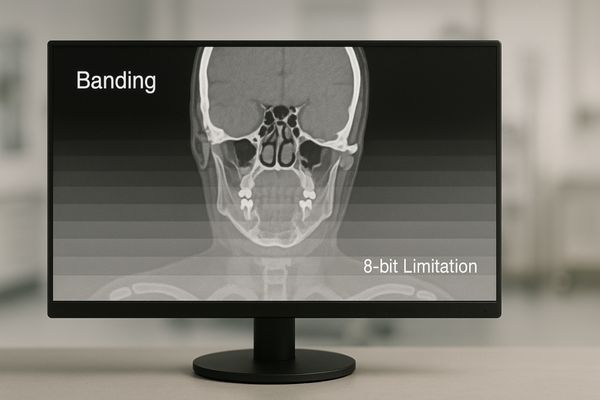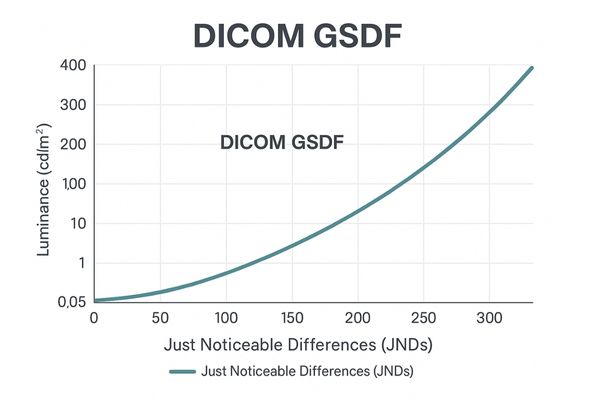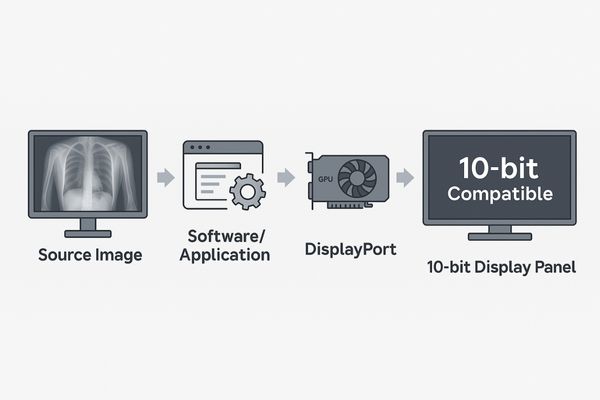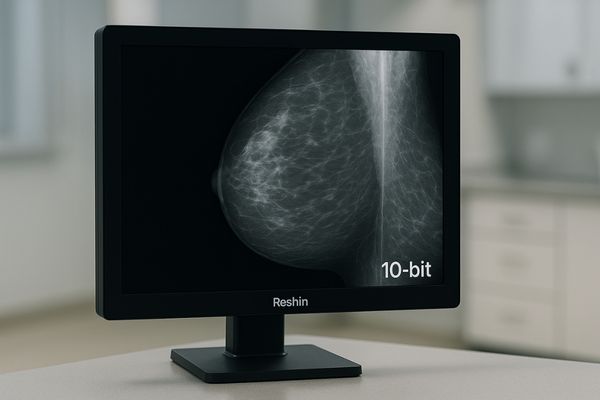Medical images contain subtle details essential for diagnosis. An 8-bit display can miss these vital nuances, leading to clinical uncertainty. A 10-bit display reveals every shade, ensuring diagnostic confidence.
This article compares 10-bit and 8-bit grayscale performance in medical displays. I will examine grayscale transitions, visual artifacts like banding, impact on diagnostic accuracy, DICOM compliance, image contrast, hardware requirements, and Reshin’s adoption of 10-bit technology in its diagnostic-grade monitors.

The differentiation between an 8-bit and 10-bit grayscale display is not a minor technical specification; it is a critical factor that directly influences clinical outcomes. An 8-bit system can render 2^8, or 256, distinct shades of gray. While sufficient for general computing, this limited palette is inadequate for the complexities of medical imaging. Modalities like CT scans and digital mammography capture vast amounts of data where subtle variations in tissue density are represented by minute differences in gray values. A 10-bit display1, capable of rendering 2^10, or 1024, shades of gray, provides four times the grayscale information. This expanded palette allows for the visualization of extremely subtle gradients, which might be entirely lost or grouped together on an 8-bit screen. This difference can mean seeing the faint edge of an early-stage tumor or missing it completely. For diagnostic displays like the MD50C, this level of precision is not a luxury but a fundamental requirement for accurate and confident interpretation. It provides the visual data integrity necessary to support critical clinical decisions.
10-bit displays offer smoother grayscale transitions
Rough, steplike gradients can obscure details. This visual noise makes it hard to distinguish adjacent tissues. A 10-bit display creates seamless transitions, revealing the true image data.
A 10-bit display renders 1024 shades of gray, four times more than an 8-bit display’s 256 shades. This increased bit depth produces exceptionally smooth tonal gradations, eliminating the visual steps seen on lower-bit-depth screens and ensuring perceptual uniformity.

The primary advantage of a 10-bit display2 lies in its ability to render a vastly more nuanced grayscale palette3. With 1024 distinct levels of gray, the transition from black to white is exceptionally smooth and continuous to the human eye. This is crucial in medical imaging, where clinicians must analyze subtle variations in tissue density. In a CT scan of the abdomen, for example, the differences in Hounsfield units between various soft tissues can be minimal. A 10-bit display can accurately represent these tiny gradations as distinct shades, allowing for clear differentiation. In contrast, an 8-bit display, with only 256 levels, is forced to group several distinct data points into a single shade of gray, effectively losing information. This results in a less detailed and potentially misleading image. The MD120C, with its 12MP resolution and 10-bit grayscale capabilities, is designed specifically to present these complex datasets with the utmost fidelity, ensuring that every piece of captured information is visible for interpretation. This smooth rendering is key to confident analysis of fine anatomical structures.
8-bit systems show visible banding in subtle gradients
Visible bands in an image are distracting artifacts. They break the illusion of a continuous tone, potentially masking pathology. This limitation of 8-bit systems is a known risk in diagnostics.
The limited 256-shade palette of an 8-bit display causes "posterization" or banding in areas of subtle grayscale change. This artifact creates false edges and contours, which can be misinterpreted as anatomical features or obscure actual pathology.

Contour banding4 is the most telling deficiency of an 8-bit display5 in a clinical context. This phenomenon occurs when a monitor does not have enough discrete gray levels to reproduce a smooth gradient, resulting in visible, step-like bands. In a radiological image, these bands can create false edges that do not exist in the source data. A clinician might mistake a banding artifact for the margin of a lesion or a subtle fracture line, leading to an incorrect diagnostic path. Conversely, the coarse steps can obscure the true texture of soft tissue, masking faint nodules or diffuse abnormalities that would be apparent on a display with smoother transitions. This is particularly problematic in low-contrast regions of an image, which are common in modalities like MRI and ultrasound. The MS270P surgical display, while designed for different use cases than diagnostics, benefits from advanced processing that minimizes such artifacts. However, for primary diagnosis, the risk of banding makes 8-bit systems unsuitable. The potential for both false positives and false negatives driven by this artifact underscores why higher bit depth is a requirement, not a preference, for diagnostic work.
Higher grayscale depth improves diagnostic accuracy
Misinterpreting a medical image can have severe consequences. Limited grayscale depth is a direct threat to accuracy. Providing more visual data through 10-bit displays helps reduce diagnostic errors and improve outcomes.
By presenting 1024 distinct gray levels, 10-bit displays enable clinicians to see subtle variations in tissue density that are invisible on 8-bit screens. This enhanced detail directly improves the detection of faint lesions, reducing missed diagnoses.

The link between grayscale depth6 and diagnostic accuracy is direct and measurable. The ability to distinguish between closely related shades of gray allows for the detection of subtle pathological indicators. For instance, in mammography, the early signs of breast cancer can manifest as microcalcifications or slight changes in tissue density that are barely perceptible. On an 8-bit display, these subtle signs may be averaged out and rendered invisible. On a 10-bit screen like the MD52G, the additional grayscale information makes these indicators stand out, increasing the sensitivity of the reading. Similarly, in neurology, a 10-bit display7 can help differentiate between gray and white matter with greater precision, aiding in the assessment of conditions like multiple sclerosis. The additional data provided by the higher bit depth gives clinicians more confidence in their interpretations. It moves the conversation from "Is there something there?" to "What is the nature of what I am seeing?" This shift from uncertainty to confidence is the core value that higher grayscale depth brings to clinical practice, directly impacting patient care for the better.
DICOM compliance favors 10-bit grayscale rendering
DICOM Part 14 is the global standard for medical image display. Non-compliance leads to inconsistent image presentation. A 10-bit system is better equipped to accurately follow the DICOM GSDF curve.
The DICOM Grayscale Standard Display Function (GSDF) requires precise luminance steps. A 10-bit display’s 1024 levels provide the granularity needed to accurately map to this curve, ensuring perceptually linear and consistent image rendering across different monitors.

The DICOM Part 14 standard is designed to ensure that a medical image looks the same regardless of which compliant monitor it is viewed on. It defines a specific relationship between the digital input values in an image and the light output (luminance) on the screen, known as the Grayscale Standard Display Function (GSDF)8. This function is perceptually linearized, meaning that each step along the curve corresponds to a just-noticeable difference (JND) to the human eye. To accurately render this precise curve, a display needs a sufficient number of gray levels. An 8-bit display has only 256 JNDs, which are often too coarse to match the GSDF smoothly, leading to approximation errors and visible banding. A 10-bit display9, with its 1024 levels, offers far more granularity. This allows it to map to the DICOM curve with much higher fidelity, resulting in a more accurate and consistent representation of the original image data. Monitors like the MD32C are built with internal 10-bit processing and calibration tools specifically to maintain strict adherence to the DICOM GSDF, guaranteeing reliable and standardized image quality for diagnostics.
DICOM GSDF Adherence: 8-bit vs. 10-bit
| Feature | 8-bit Display (256 Levels) | 10-bit Display (1024 Levels) | Clinical Impact |
|---|---|---|---|
| Granularity | Coarse | Fine | 10-bit provides smoother tonal transitions. |
| GSDF Mapping | Prone to approximation errors | High fidelity mapping | 10-bit ensures more accurate luminance output. |
| Perceptual Linearity | Visible steps (banding) | Visually continuous | 10-bit eliminates distracting artifacts. |
| Consistency | Variable between displays | Highly consistent when calibrated | 10-bit supports reliable image exchange. |
Image contrast is more consistent in 10-bit monitors
Inconsistent contrast can hide or exaggerate features. This variability makes it difficult to compare images over time. A 10-bit display provides stable, reliable contrast across the entire grayscale range.
In a 10-bit system, the greater number of steps between black and white allows for finer control over contrast. This ensures that the subtle differences in luminance are preserved accurately, especially in the darkest and brightest regions of an image.

Image contrast, particularly local contrast10, is essential for defining the edges of anatomical structures. A medical display must be able to render subtle differences in brightness consistently across the entire luminance range. On an 8-bit monitor, the large jumps between gray levels can cause "crushing" in the darkest parts of an image (where different dark shades all become pure black) and "clipping" in the brightest parts (where different bright shades become pure white). This loss of detail in the tonal extremes can obscure important diagnostic information. A 10-bit display, with its finer gradations, mitigates this issue significantly. It can reproduce details in deep shadows and bright highlights with much greater accuracy. This means a surgeon using a monitor like the MS321PC can clearly see details inside a poorly illuminated body cavity, or a radiologist can analyze dense bone structure without losing the surrounding soft tissue detail. The consistency of contrast provided by the higher bit depth ensures that the full dynamic range of the imaging modality is faithfully represented on the screen.
Data bandwidth and GPU support impact grayscale depth
Displaying 10-bit color is not just about the panel. The entire imaging chain must support it. A bottleneck anywhere from the GPU to the cable can downgrade the signal to 8-bit.
True 10-bit output requires a supportive ecosystem. The graphics card (GPU), display driver, operating system, and connecting cable (like DisplayPort) must all be capable of transmitting a 10-bit signal to the monitor panel.

Achieving a true 10-bit grayscale signal1 on screen is a system-level challenge. A 10-bit display panel is the final component, but the entire chain preceding it must be compatible. The source image data must contain more than 8 bits of information. The application software and operating system must be able to process and pass this data without truncation. The graphics card (GPU) and its drivers need to be professional-grade, such as those from the NVIDIA Quadro2 or AMD Radeon Pro series, which explicitly support 10-bit color depth per channel. Finally, the physical connection between the computer and the monitor must have sufficient bandwidth; DisplayPort is the standard for this, as many older DVI or HDMI versions are limited to 8-bit. If any link in this chain fails, the monitor may receive only an 8-bit signal, negating the benefits of its advanced panel. For setups using a multi-modality diagnostic monitor like the MD85CA, ensuring the workstation’s GPU can drive the high resolution at 10-bit depth is a critical part of the system integration to unlock its full diagnostic potential.
Reshin adopts 10-bit panels in diagnostic-grade displays
To meet modern clinical demands, we must use the best technology available. 8-bit panels are insufficient for primary diagnosis. We have committed to using 10-bit panels for our diagnostic displays.
All our diagnostic displays are built on 10-bit panel technology. This commitment ensures our monitors deliver the superior grayscale fidelity required for accurate diagnosis, DICOM compliance, and the visualization of subtle pathologies in modern medical imaging.

Recognizing the clinical importance of grayscale fidelity, our design philosophy for diagnostic monitors is centered around 10-bit technology11. It is not an optional feature but a core component of the product’s architecture. We integrate 10-bit (or higher) lookup tables (LUTs) and processing to ensure that the full bit depth is utilized effectively for calibration and DICOM conformance12. This commitment starts with panel selection and extends through the entire signal path within the monitor. By standardizing on 10-bit panels for models ranging from general radiology to specialized mammography, such as the MD33G, we provide a consistent and reliable platform for healthcare institutions. This approach ensures that clinicians have the best possible tool for their work, enabling them to see more detail and make diagnoses with greater confidence. It aligns with the broader move toward precision medicine, where every piece of data is critical. We believe that providing this level of visual accuracy is a fundamental responsibility for a manufacturer of medical-grade displays.
Conclusion
The shift from 8-bit to 10-bit grayscale is not an incremental upgrade; it is a fundamental evolution in medical imaging that directly enhances diagnostic accuracy and patient safety.
📩 Want to experience the clinical benefits of 10-bit grayscale displays? Contact Martin at martin@reshinmonitors.com to explore Reshin’s high-precision imaging solutions.
-
Explore how a 10-bit display enhances medical imaging accuracy, crucial for early diagnosis and treatment. ↩ ↩
-
Explore this link to understand how 10-bit displays enhance image quality in medical imaging, crucial for accurate diagnosis. ↩ ↩
-
Discover how a nuanced grayscale palette aids in distinguishing subtle differences in medical images, vital for effective treatment. ↩
-
Understanding contour banding is crucial for clinicians to avoid misdiagnosis and ensure accurate imaging. ↩
-
Exploring the limitations of 8-bit displays can help professionals choose better imaging solutions for accurate diagnostics. ↩
-
Understanding grayscale depth is crucial for improving diagnostic accuracy in medical imaging, enhancing patient care. ↩
-
Exploring the benefits of a 10-bit display can reveal how it enhances image quality and diagnostic confidence in clinical settings. ↩
-
Understanding GSDF is crucial for ensuring accurate medical image representation across different displays. ↩
-
A 10-bit display significantly enhances image quality, making it essential for precise diagnostics in medical imaging. ↩
-
Understanding local contrast is crucial for improving image quality in medical displays, enhancing diagnostic accuracy. ↩
-
Explore this link to understand how 10-bit technology enhances image quality and diagnostic accuracy in medical displays. ↩
-
Learn about DICOM conformance to see how it ensures interoperability and quality in medical imaging systems. ↩

